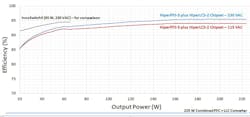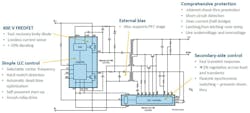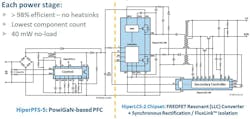Resonant Power-Converter/PFC Chipset Slashes Component Count
This article is part of our APEC 2022 coverage.
Greetings from Houston, Texas, the oil-rich city of paradox where the art car movement was born. Houston also is where the 2022 APEC power technology conference was held in-person for the first time since 2019. Excitement and innovation were in abundance at the show, including at the Power Integrations booth, where I met with Doug Bailey, PI's VP Marketing. He introduced me to the company’s latest family of highly integrated resonant power-converter and power-factor-correction (PFC) ICs.
These devices are intended to simplify the development of compact, super-efficient, power adapters; open-frame power supplies for TVs; monitors with USB PD ports; all-in-one PCs; game consoles; and battery chargers for power tools and e-bikes.
These devices reflect the company’s longtime commitment to creating electronic components that make it easier and more economical for manufacturers to create eco-friendly products meeting, and often exceeding, global efficiency standards being put in place to combat climate change.
Green to the Bone
Power-supply designs based on the new HiperLCS-2 chipset can provide a continuously regulated output that complies with the world's most stringent no-load and standby efficiency regulations. Both the primary and secondary controllers operate above 95% efficiency across nearly their entire load range. They also draw less than 50 mW under no-load conditions at 400-V dc input.
Resulting heat dissipation is low enough to permit direct heat dissipation through the circuit's FR4 PCB material. Thus, it eliminates the need for heatsinks in adapter designs up to 220 W (continuous output with up to 170% peak power capability).
Similarly, PI's HiperPFS-5 companion family of PFC ICs enables designers to address the growing number of markets that require even lower-power electronic products to have PFC capabilities.
Powerful Building Blocks
Power Integrations created the HiperLCS-2 chipset family to simplify the design and reduce the cost of high-efficiency LLC resonant power-converter solutions from 80 to 270 W. Complementing the new switcher series is the HiperPFS-5 family, a series of high-efficiency quasi-resonant PFC ICs that feature an integrated 750-V gallium-nitride (GaN) switch. Together, they form the building blocks for PFC power supplies, capable of delivering up to 200+ W at over 95% efficiency across virtually their entire load range.
The dual-chip solution features an isolation device with a high-bandwidth LLC controller, a synchronous rectification driver, and a separate half-bridge power device utilizing PI’s unique 600-V FREDFETs with lossless current sensing and high- and low-side drivers.
The secondary-side controller uses the company’s exclusive FluxLink safety-isolated high-speed digital feedback control to synchronize switching. It allows supplies based on the HiperLCS-2 chipset to achieve regulation accuracy of under 1% across line and load range and across production variations. In addition, it provides much faster transient response and greater long-term reliability than optocouplers.
All HiperLCS-2 family members feature self-powered startup and provide the startup bias for an optional PFC stage. Secondary-side sensing provides less than 1% regulation accuracy across line and load range and across production variations. The use of FluxLink technology for safety-isolated, high-speed digital feedback control provides much faster transient response and better long-term reliability than optocoupler-based isolation circuits.
PFC Without Tears
Featuring an integrated 750-V GaN switch based on PI's PowiGaN technology, the HiperPFS-5 family of PFC ICs can deliver up to 240 W without a heatsink at efficiencies of up to 98.3% while achieving a power factor of better than 0.98. The highly integrated ICs, based on a quasi-resonant (QR), variable-frequency discontinuous-conduction-mode (DCM) boost PFC topology, require only a small number of external passives to implement compact, efficient power-factor stages.
The PFC controller can be seamlessly paired with the new HiperLCS-2 power-converter chipset for use in many electronic appliances like those mentioned earlier. It can also be used with the company's InnoSwitch4-CZ active-clamp flyback ICs.
HiperPFS-5 PFCs’ DCM control technique adjusts the switching frequency across its output load, input line voltage, and input line cycle. QR DCM control ensures low switching losses and permits the use of a low-cost boost diode. Thanks to the variable-frequency engine, boost inductor size can be reduced by more than 50% compared to conventional critical-conduction-mode (CRM) boost PFC circuits.
At light loads, an integrated power-factor-enhancement (PFE) feature compensates for input filter capacitance, maintaining a high PF of 0.96, even at 20% load. No-load power consumption is just 38 mW.
The HiperPFS-5 ICs are designed to operate reliably even in locations where the mains power can be highly unstable, which often leads to overvoltage failures in conventional converters. As a result, they maintain a high power factor up to 305 V ac and can operate continuously at up to 460 V ac during line swells. The controller's low-profile, InSOP-T28F SMD power package features exposed cooling pads that remain at source potential, providing effective cooling and simplifying the EMI solution.
Pricing and Development Resources
Both devices in the HiperLCS-2 chipset are housed in low-profile InSOP-24 packages. Pricing starts at $3.20 per chipset in 10,000-unit quantities. HiperPFS-5 QR PFC controller devices are priced at $2.34 in 10,000-unit quantities.
Designers wishing to evaluate the HiperLCS-2 LLC resonant power converter ICs and the HiperPFS-5 quasi-resonant PFC controller ICs may download reference design DER-672.




